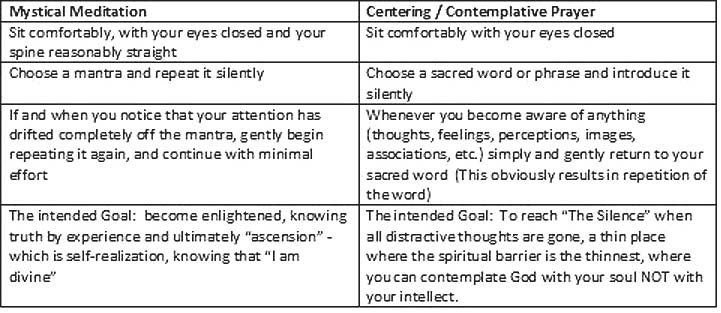As discussed in Part 1 of this series, the New (Age) Spirituality which is “paganism (the occult) in modern dress” continued to grow through the 1990s and has become even more prominent during the first decade of the 21st century. It currently can be found in the work place, hospitals, public schools, prisons, on television, in bookstores, and as we will be discussing, it has been welcomed by the Church with open arms!
In 2 Corinthians 2:11, Paul took it for granted that the people of Corinth were not ignorant of Satan’s devices. Sadly, that can’t be said of many believers today. The discernment skills of many believers are either very weak or nonexistent. The combination of a profound Biblical illiteracy and lack of a literal hermeneutic; i.e., “God says what He means and means what He says,” has left the church wide open for New (Age) Spirituality deception.
Spiritual Discernment and the Mature Believer
Both Hebrews 5:14 and Ephesians 4:14 describe the discernment skills characteristic of a mature believer. Specifically, Hebrews 5:14 describes a mature believer as one who through practice has exercised vigorously their faculty of the mind for perceiving, understanding, and judging to discern both good and evil—truth and lie.
Although there is a specific gift of the Spirit given to some, called “discerning of spirits,” as spoken of in 1 Corinthians 12:10, the discernment skills referenced by both Hebrews 5:14 and Ephesians 4:13, 14, are characteristic of ALL mature believers.
Jesus declares in John 17:17, “Thy Word is Truth.” Mature believers use objective reasoning skills to compare unfamiliar or new teachings and practices with the Truth of God’s Word to prove all things. The word “prove” as used in 1 Thessalonians 5:21 means: to test, examine, prove, scrutinize (to see whether a thing is genuine or not), to recognize as genuine after examination.
As mature believers, let’s examine some of the main forms of New (Age) Spirituality that have crept into the Church.
“Christian” Yoga?
Mystical Meditation is the foundation of New (Age) Spirituality and has entered the Church in two main forms. The most transparent of which is called “Christian” Yoga.
The word “yoga” comes from the Hindu Sanskrit root “yuj,” which means “to join” or “to yoke.” The question then comes to mind, what is the practitioner joining with?
Traditionally, yoga is a method joining the individual self with the Divine, Universal Spirit, or Cosmic Consciousness. Physical and mental exercises are designed to help achieve this goal, also called self-transcendence or enlightenment.1
This “joining” is becoming one with the divine and becoming enlightened to the fact that you are divine—self-realization. All creation is God (Pantheism) and God is in all creation (Panentheism)—God is everywhere and is in everyone.
Some supporters and promoters of “Christian” Yoga claim they only use the physical exercises (as in the Hatha form of Yoga). Their intentions are to worship God, not the Hindu gods, so they have no problem with “Christian” Yoga.
However, Hatha Yoga concentrates on the Yoga positions called Asanas. In Hinduism everything is god. Each position is representative of a different being of creation. Hinduism teaches that the creative force that runs through all creation is called Kundalini.
The Sanskrit word Kundalini means “the curled one,” and is referenced as Kundalini awakening or the awakening of the serpent power (Kundalini Shakti). Jean Lim, author/speaker and expert on the supernatural states:
Yoga is actually a form of spiritual exercise, and those who practice Yoga will be filled with the spirit of Yoga, which is the spirit of the serpent…I don’t think we can separate Yoga, the practice of Yoga, from the spiritual into just a form of exercise, because every form of the Yoga movement derives from the serpent and there is a root behind it, so when a person practices Yoga, they actually are inherently bowing down to the god of the serpent.2
God commands His people to not bow down or worship any other god in Exodus 34:14. The Israelites are warned in Joshua 23:7 that when “ye come among these nations, these that remain among you; neither make mention of the name of their gods, nor cause to swear [by them], neither serve them, nor bow yourselves unto them.”
"Christian” Yoga is as incongruous as “Christian” Ouija. Intent doesn’t matter. You wouldn’t use Yoga to worship the true God anymore than you would use a Ouija board to speak to Jesus Christ. Both are entry points into the spirit world that open the door to spiritual deception.
There are many believers who understand this concept and do not have anything to do with Yoga. However, they may have fallen for something even more deceptive.
Centering / Contemplative Prayer
The terms Centering Prayer and Contemplative Prayer are becoming well known in Christian circles. For the most part, these terms have been used interchangeably. However, Centering Prayer appears to be the methodology which creates the “spiritual” environment for Contemplative Prayer, which is defined as contemplating God with the soul, not with your mind or rational thought.
Centering Prayer/Contemplative Prayer was brought into the Roman Catholic Church in 1977 by three trappist monks: (Abbot) Thomas Keating, William Meninger, and Basil Pennington. This was in response to Vatican Council II’s call for “the revitalization of the path of contemplative prayer.”
These three joined with ecumenically oriented Catholic theologians, an Eastern Zen master who offered retreats on Buddhist meditation, and a former trappist monk who taught transcendental meditation. Together they created “centering prayer.”
In the forward to the book Kundalini Energy and Christian Spirituality by Philip S. Romain, Thomas Keating (the most famous of the three trappist monks) wrote:
Reading the Christian mystics from the perspective of his [Philip St. Romain] own experience of kundalini energy, the author sees many examples of its working in the lives of Christian saints and mystics. Since this energy is also at work today in numerous persons who are devoting themselves to contemplative prayer, this book is an important contribution to the renewal of the Christian contemplative tradition. It will be of great consolation to those who have experienced physical symptoms arising from the awakening of kundalini in the course of their spiritual journey, even if they have not experienced it to the fullest extent described by the author. His [Philip St. Romain] compelling testimony is a powerful affirmation of the potential of every human being for higher states of consciousness.3
Although its proponents will argue against it, Centering/Contemplative Prayer is most definitely a form of Eastern Meditation, i.e. Mystical Meditation. On page 20 there is a chart comparing what is taught by the New (Age) Spirituality and the method of meditation that is taught for Centering/Contemplative Prayer. As you will notice, the steps taken are identical. Both use the same method to induce an altered state of consciousness—void of thought, just contemplating spiritual truth in an experiential fashion and accepting it as truth without discernment. This is a spiritually dangerous condition. The door to the spiritual realm of intense experience becomes the basis for truth instead of the Word of God.

Be Not Deceived
Each believer has the ultimate responsibility to use his/her discernment skills and not be deceived. However, the shepherds of the flock such as pastors, Bible teachers and Christian leaders also bear responsibility for teaching the whole counsel of God and warning of false doctrine. In Paul’s farewell instructions to the Ephesian elders in Acts 20, Paul declared:
For I have not shunned to declare unto you all the counsel of God. Take heed therefore unto yourselves, and to all the flock over the which the Holy Ghost hath made you overseers, to feed the church of God, which he hath purchased with his own blood. For I know this, that after my departing shall grievous wolves enter in among you, not sparing the flock. Also of your own selves shall men arise, speaking perverse things to draw away disciples after them. Therefore watch, and remember, that by the space of three years I ceased not to warn every one night and day with tears.
Acts 20:27-31
May all pastors as shepherds of the flock of Jesus Christ follow Paul’s example, and may we as believers practice our discernment skills and heed Jesus’ warnings to “be not deceived.”
Notes:
- “Yoga Definition” Answers.com; http://www.answers.com/topic/yoga.
- Matrisciana, Caryl. “Yoga Uncoiled Part III”; http://www.radiofreechurch.com/topics_display?page=31&sort=alpha.
- Philip St. Romain, Kundalini Energy and Christian Spirituality: A Path to Growth and Healing, pp 7; New York: The Crossroads Publishing Company, 1994.





